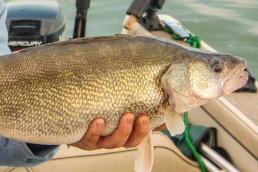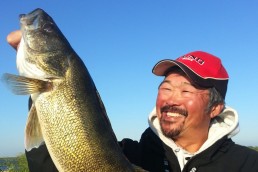Working the Wood for more Walleyes
SHARE THIS POST
With the river fishing environment being so totally different than fishing lakes, it makes sense that in order to be successful you have to adjust your tactics. On rivers like the Mississippi, Wisconsin and Rock here in the Midwest, fishing for walleyes can either be boom or bust. With this fact in mind, let’s talk about a very deadly tactic I wish more anglers would use to be successful when searching out those hungry walleyes.
In most years, the rivers here in the Midwest have high levels from the runoff of snowmelt. When this happens, the walleyes are looking for places in which they can gather and avoid the fast currents that go along with the spring. With high water usually the rule, the fish are actually very predictable as to what types of locations they will be using. The problem is, though, that many anglers fail to read the water conditions at hand and miss out on some excellent fish-holding locations.
Over the years, I have found that while tail-water fishing these river systems seems to be the norm in the spring of the year, there is another area that anglers overlook that hold large numbers of quality walleye. I’m talking about the flooded timber and willows that line the banks of these great rivers.
One thing that I want to make perfectly clear is that in high water conditions, do not be afraid to get out and fish. Many anglers I have talked to have felt that high water fishing is a waste of time. Not so my friends, not so. You have to remember the fish have not left the river. They have just repositioned themselves as to where they are now living. With that thought in mind, let’s go catch some spring walleyes.
When heading out and looking for these walleyes holding in the flooded willows and timber, it sometimes can get mind-boggling as just where to start your search. With so much visible flooded area to see, it can get confusing.
When searching these flooded willow and timber areas, I tell folks to look for a few things before you start fishing. Look for areas that are preferably off the main channel of the river if possible. These areas will in most instances have much less strong current and the fish will be more comfortable holding there. Bays and cuts leading to slough areas are prime for this type of fishing. You have to also consider that the baitfish the walleyes are feeding on will use these types of areas also, which makes it even more attractive to the walleyes looking for an easy meal. The ability to stay out of the heavy current and have food available makes this an excellent location.
Now that we have an idea of just what types of areas that we want to find for these spring walleyes, let’s touch on just how we are going to fish for them. The presentation that you use in these high water, flooded willow and timber situations will be critical if you want to catch fish or not.
Over the years, I have had my best luck fishing these conditions by taking a page from the bass fishing crowd. In short, using the “pitching and flipping” method of bait presentation.
Are you enjoying this post?
You can be among the first to get the latest info on where to go, what to use and how to use it!
There are many different methods that one can use, but I’m going to tell you about one of my all time most successful ones. I am speaking of using a hair jig and plastics.
To get to these walleyes that holding tight in the flooded cover, I like to take a plastic bait know as a Ringworm. I find this bait works very well for this type of fishing. But I do modify it just a bit. I’ll get to that in a minute.
Next, I will use a bucktail hair jig for my hook setup. I make my own jigs but you can buy bucktails in the store. Typically for this fishing I use a 5/16-ounce jig that has shown to be the perfect weight for most applications. Now comes the rigging part.
Most Ringworm plastics come in the 4-incg size. I have found that’s too long for this presentation. So what I have found that works well is to cut about 1 1/2 to 1 3/4 inches off the front of the ringworm. After doing this, you will want to thread it onto your bucktail jig, being careful not to push it on too far. The reason for this is not to spread that bucktail open which looks totally unnatural. Just slide it on far enough to be secure and against the hair of the bucktail. That simple—you now have a proven walleye-catcher.
To fish this setup, you can simply drift downriver while pitching and flipping it into the flooded cover. I like to use the bow electric motor on my boat to help me from moving too fast when the current is swift. When you make your flip or pitch, let the jig settle to the bottom and then ever so slowly start swimming it back to you. Try different cadences until you find one the fish like and then just repeat it. Note: When fish are aggressive, you can use the faster snap-jigging method also. Again, let the fish tell you what they want.
One last thing, don’t worry if every flip is not tight to the bottom. In these more shallow waters, the walleyes will rise to hit the jig. Also, don’t forget that these waters can be turbid and dark in color, so start with a dark-colored combination on your jig.
When you’re out on your favorite river, start working that flooded wood. You just might catch the biggest walleye of your life.
Email your outdoor questions to Mike Cyze at: lastcast13@yahoo.com. You can also check out Cyze’s Blog at: lastcastoutdoors.com or listen to him on ESPN Radio.
MWO
SHARE THIS POST
Did you enjoy this post?
You can be among the first to get the latest info on where to go, what to use and how to use it!
Mike Cyze
Mike Cyze has been called one of the most knowledgeable multispecies river anglers in the country. His ability to catch fish under the challenging conditions encountered in the river environment, combined with his overall fishing knowledge, has earned him recognition as a true Mississippi River Expert. Contact him at: lastcast13@yahoo.com.



